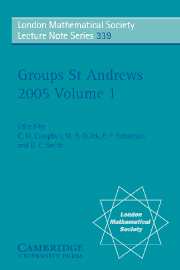Book contents
- Frontmatter
- Contents
- Introduction
- Aspects of infinite permutation groups
- Self-similarity and branching in group theory
- On surface groups: motivating examples in combinatorial group theory
- Nilpotent p-algebras and factorized p-groups
- Classification of finite groups by the number of element centralizers
- Algorithmic use of the Mal'cev correspondence
- Minimal but inefficient presentations for semi-direct products of finite cyclic monoids
- The modular isomorphism problem for finite p-groups with a cyclic subgroup of index p2
- On one-generated formations
- New results on products of finite groups
- Radical locally finite T-groups
- Explicit tilting complexes for the Broué conjecture on 3-blocks
- Conjugacy classes of p-regular elements in p-solvable groups
- An algorithm for the unit group of the Burnside ring of a finite group
- Integral group ring of the first Mathieu simple group
- Embedding properties in direct products
- Malcev presentations for subsemigroups of groups — a survey
- Finite groups with extremal conditions on sizes of conjugacy classes and on degrees of irreducible characters
- Conjugacy class structure in simple algebraic groups
- On automorphisms of products of groups
- Linear groups with infinite central dimension
- G-automata, counter languages and the Chomsky hierarchy
- An embedding theorem for groups universally equivalent to free nilpotent groups
- Irreducible word problems in groups
- Recent growth results
Aspects of infinite permutation groups
Published online by Cambridge University Press: 07 May 2010
- Frontmatter
- Contents
- Introduction
- Aspects of infinite permutation groups
- Self-similarity and branching in group theory
- On surface groups: motivating examples in combinatorial group theory
- Nilpotent p-algebras and factorized p-groups
- Classification of finite groups by the number of element centralizers
- Algorithmic use of the Mal'cev correspondence
- Minimal but inefficient presentations for semi-direct products of finite cyclic monoids
- The modular isomorphism problem for finite p-groups with a cyclic subgroup of index p2
- On one-generated formations
- New results on products of finite groups
- Radical locally finite T-groups
- Explicit tilting complexes for the Broué conjecture on 3-blocks
- Conjugacy classes of p-regular elements in p-solvable groups
- An algorithm for the unit group of the Burnside ring of a finite group
- Integral group ring of the first Mathieu simple group
- Embedding properties in direct products
- Malcev presentations for subsemigroups of groups — a survey
- Finite groups with extremal conditions on sizes of conjugacy classes and on degrees of irreducible characters
- Conjugacy class structure in simple algebraic groups
- On automorphisms of products of groups
- Linear groups with infinite central dimension
- G-automata, counter languages and the Chomsky hierarchy
- An embedding theorem for groups universally equivalent to free nilpotent groups
- Irreducible word problems in groups
- Recent growth results
Summary
Abstract
Until 1980, there was no such subject as ‘infinite permutation groups’, according to the Mathematics Subject Classification: permutation groups were assumed to be finite. There were a few papers, for example [10, 62], and a set of lecture notes by Wielandt [72], from the 1950s.
Now, however, there are far more papers on the topic than can possibly be summarised in an article like this one.
I shall concentrate on a few topics, following the pattern of my conference lectures: the random graph (a case study); homogeneous relational structures (a powerful construction technique for interesting permutation groups); oligomorphic permutation groups (where the relations with other areas such as logic and combinatorics are clearest, and where a number of interesting enumerative questions arise); and the Urysohn space (another case study). I have preceded this with a short section introducing the language of permutation group theory, and I conclude with briefer accounts of a couple of topics that didn't make the cut for the lectures (maximal subgroups of the symmetric group, and Jordan groups).
I have highlighted a few specific open problems in the text. It will be clear that there are many wide areas needing investigation! I have also included some additional references not referred to in the text.
Notation and terminology
This section contains a few standard definitions concerning permutation groups. I write permutations on the right: that is, if g is a permutation of a set Ω, then the image of α under g is written αg.
- Type
- Chapter
- Information
- Groups St Andrews 2005 , pp. 1 - 35Publisher: Cambridge University PressPrint publication year: 2007
- 6
- Cited by



